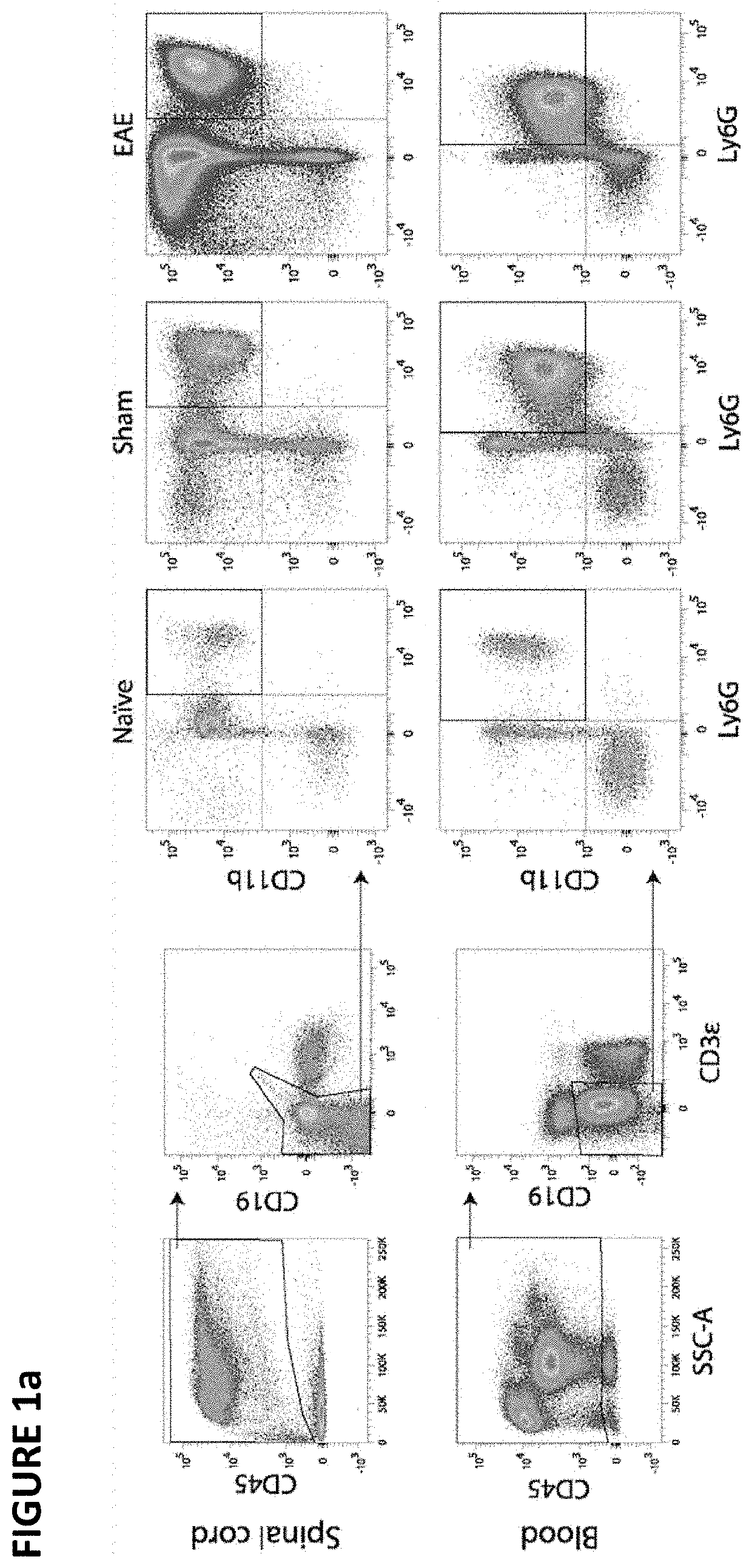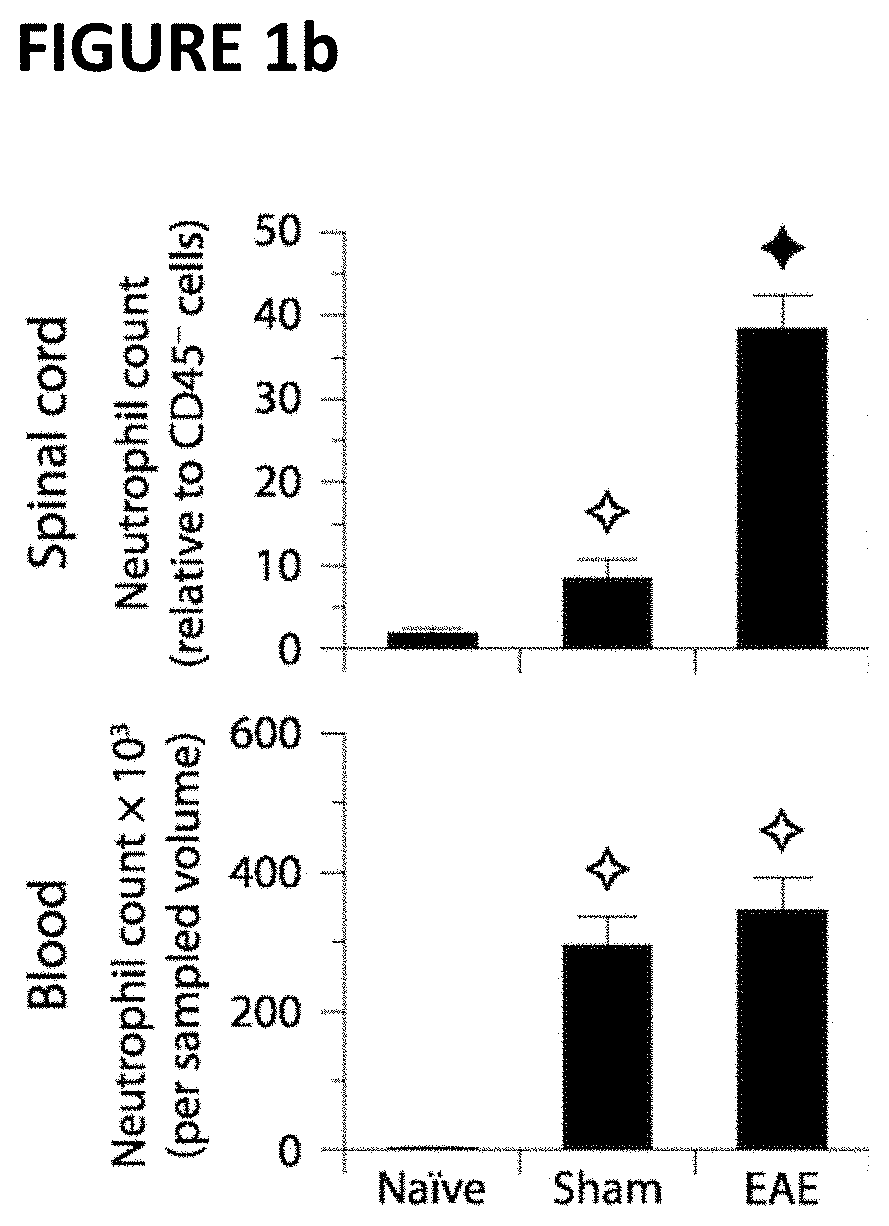Asprv1 as a neutrophil-specific marker and therapeutic target for inflammatory diseases
a technology of neutrophils and receptors, applied in the field of aspartic peptidase retrovirallike 1, can solve the problem of elusive exact functions of aspartic peptidase retrovirallike 1
- Summary
- Abstract
- Description
- Claims
- Application Information
AI Technical Summary
Benefits of technology
Problems solved by technology
Method used
Image
Examples
example 1
tinguishes Extra- from Intravascular Neutrophils in the CNS of EAE Mice
[0112]To study the phenotype of neutrophils in EAE, cell-surface markers (CD45, CD11b, Ly6G, ICAM1) were analyzed by flow cytometry in the spinal cord and blood of mice immunized with MOG35-55 and adjuvants (i.e. complete Freund's adjuvant and pertussis toxin). Sham-immunized mice (adjuvants only) and naïve mice were used as controls. Samples were taken at day 15 post-immunization—a time point at which all mice had developed signs of EAE (mean clinical score, 1.9±0.2) and at which neutrophils were expected to be mobilized to the CNS15-17.
[0113]As shown in FIG. 1a-b, neutrophils (CD45+CD11b+Ly6G+) were expanded in the spinal cord and blood of both EAE mice and sham-immunized mice relative to naïve controls. While this cell expansion in the blood was comparable between these two groups, it was 4.3 times higher in the CNS of EAE mice relative to sham-immunized mice (FIG. 1b). These results are consistent with the pr...
example 5
Specifically Expressed by Neutrophils in Mouse and Human, and Correlates with Neutrophil Infiltration in Demyelinating Autoimmune Diseases
[0128]Seeking to discover a unique function of neutrophils in EAE, we chose to follow up on ASPRV1, because it was the most highly expressed neutrophil-specific gene with a human homolog that had not yet been studied in the immune or nervous system, and because it encodes a little-known protease that could play a novel effector role in inflammation. By RT-qPCR, we found that ASPRV1 mRNA was indeed expressed in neutrophils (ICAM1+ and ICAM1−) extracted by FACS from EAE spinal cords, but not in any other immune cell types tested (FIG. 7a). ASPRV1 protein was also expressed in neutrophils from mouse bone marrow, as revealed by Western blotting with the same antibody used to first detect ASPRV1 in skin9 (FIG. 7b). Specificity was confirmed by the absence of signal in mononuclear leukocytes and ASPRV1− / − neutrophils (FIG. 7b). In whole spinal cord extr...
example 6
Required for the Chronic Phase of a B Cell-Dependent EAE Model
[0130]To determine whether ASPRV1 contributes to EAE, we immunized ASPRV1-deficient and wild-type mice with two different antigens: the standard MOG35-55 peptide and bMOG. bMOG is a novel “humanized” mouse MOG1-125 protein that bears the S42P mutation abolishing the immunodominant T-cell epitope (amino acids 35-55). bMOG can still induce EAE with prominent neutrophilic infiltration, but contrary to MOG peptide33, it acts through a B cell-dependent mechanism. This was demonstrated in B1-8+ / +Jκ− / − mice expressing a single B cell receptor to an irrelevant antigen, which mice did not develop EAE in response to bMOG (FIG. 12). Therefore, compared to MOG35-55, bMOG induces a form of EAE that is more similar to MS as it involves pathogenic B cells.
[0131]After immunization with MOG35-55, no difference was observed in EAE incidence and severity between ASPRV-1− / − and wild-type mice (FIG. 8a-c). In contrast, with bMOG, EAE incidenc...
PUM
| Property | Measurement | Unit |
|---|---|---|
| Fraction | aaaaa | aaaaa |
| Fraction | aaaaa | aaaaa |
| Length | aaaaa | aaaaa |
Abstract
Description
Claims
Application Information
 Login to View More
Login to View More - R&D
- Intellectual Property
- Life Sciences
- Materials
- Tech Scout
- Unparalleled Data Quality
- Higher Quality Content
- 60% Fewer Hallucinations
Browse by: Latest US Patents, China's latest patents, Technical Efficacy Thesaurus, Application Domain, Technology Topic, Popular Technical Reports.
© 2025 PatSnap. All rights reserved.Legal|Privacy policy|Modern Slavery Act Transparency Statement|Sitemap|About US| Contact US: help@patsnap.com



